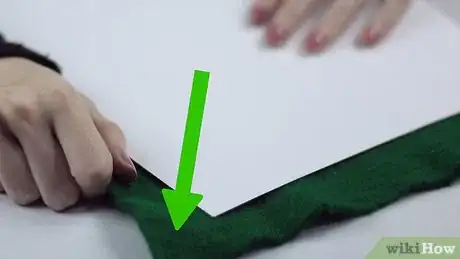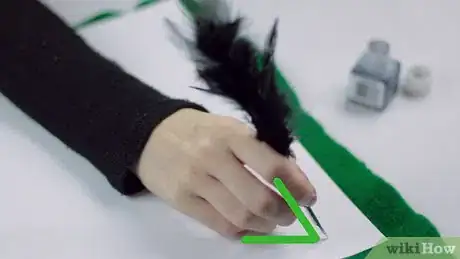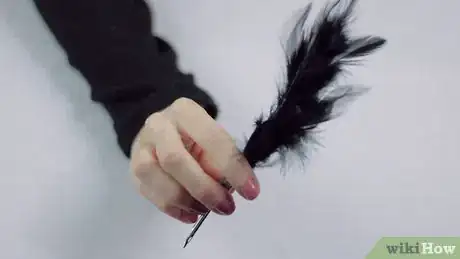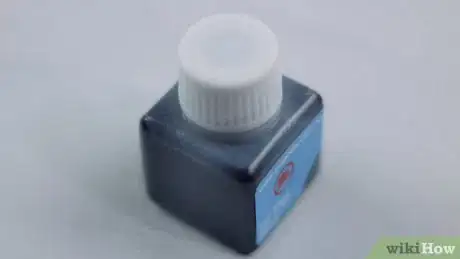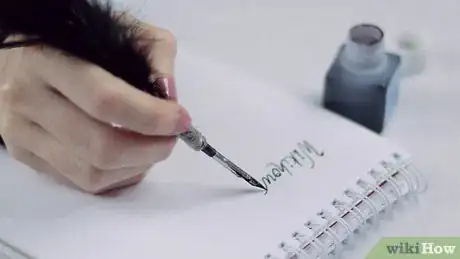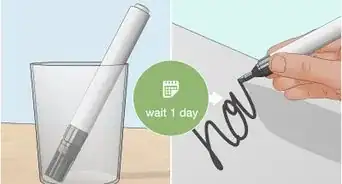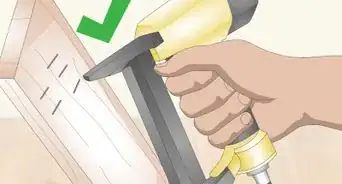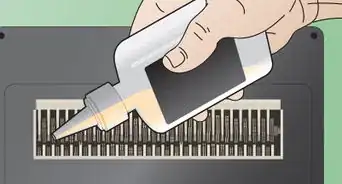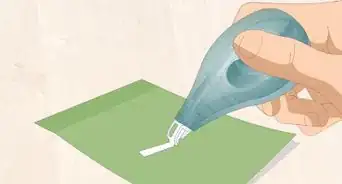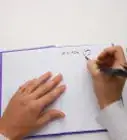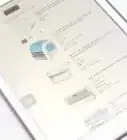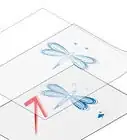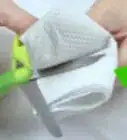This article was co-authored by wikiHow Staff. Our trained team of editors and researchers validate articles for accuracy and comprehensiveness. wikiHow's Content Management Team carefully monitors the work from our editorial staff to ensure that each article is backed by trusted research and meets our high quality standards.
There are 11 references cited in this article, which can be found at the bottom of the page.
wikiHow marks an article as reader-approved once it receives enough positive feedback. In this case, 83% of readers who voted found the article helpful, earning it our reader-approved status.
This article has been viewed 233,171 times.
Learn more...
The art of writing with a quill pen interests people from many walks of life—artists, students, teachers, etc. Though not as popular as other modern writing utensils, the feather quill is still made and broadly used today. The same is true of more recently invented metal-nibbed (tipped) pens and fountain pens.[1] While using a quill pen requires more steps than using a ball-point pen, it’s easy to master with a little bit of time and patience.
Steps
Holding Your Feather Quill
-
1Use a cushion. Place a flat felt cushion under the paper. This will keep the quill nib sharper longer.[2] A quill pen can only be sharpened so many times before it becomes unusable. Pens that don’t have to be sharpened as often will last longer.
-
2Hold the quill like a regular pen. Let the quill rest between your thumb and forefinger. Grip the area above the nib with you thumb and forefinger. If the quill is made from a natural feather, don’t squeeze too hard. Otherwise, you could crack it and make it unusable.Advertisement
-
3Dip the quill in the ink. Submerge the nib in the inkwell. Slowly draw it up. Scrape the excess ink off the nib and back into the well. Too much ink will bleed through the paper, possibly wasting an entire sheet. If you don’t get enough ink on the quill, you can at least redip it into the ink. You’ll have to dip your quill regularly as you write. Each dip will give you about three to six words.[3]
-
4Position the nib at an angle. Advice ranges from a downward angle of 45 degrees to perpendicular (90 degrees). The nib should face left for right-handed people and right for left-handed people. This will ensure thin, manageable lines. If your nib faces straight up or down, it will produce lines that are too thick to form legible words.
Writing with Your Quill
-
1Write until you need to dip your quill again. Apply very light pressure to the paper.[4] Too much pressure could break your pen, tear the paper, or dull the nib too quickly. As you write, try to do so until you need to redip your pen. Stopping too often will cause unsightly ink blobs on your paper.
-
2Finish with sand. When you have finished writing, sprinkle sand on top of the inked paper. This will soak up any excess ink without destroying your writing. Let the sand sit for a few minutes. Then, either shake or blow the sand off the paper.[5] You should do this either outside or over a trash can to avoid making a mess.
-
3Rinse the nib. Whether the nib is the shaft of a feather or a metal nib, you should rinse it thoroughly with water after writing. This will prolong your quill’s lifespan and ensure the quality of the instrument is maintained.
-
4Dry the nib. If you use a natural feather pen, let the cleaned shaft air dry. It will reconstitute and harden on its own.[6] A metal nib, on the other hand, should be dried gently with a cloth towel or paper towel. Like any form of metal, it can rust if water is left on the surface too long.
Selecting and Caring for Your Quill
-
1Go to a specialty store. Quill pens are not available everywhere. The easiest place to find quill pens is an online store such as Etsy or Amazon or your local art supply store. If you live near a historic site, you could check the gift shop for inexpensive quill pens.
- Traditional quill pens are large feathers whose shafts have been hollowed out as ink reservoirs. These pens tend to have softer tips that are less likely to puncture paper.[7]
- Quill pens with metal nibs have been widely available since the early nineteenth century.[8]
- If you’re feeling crafty, you can make your own pen.
-
2Sharpen natural quills. If you have a traditional quill made entirely from a feather, you will have to sharpen the nib periodically.[9] One telltale sign of a dull nib is an increased amount of ink flooding onto the paper. Using a penknife, extend the slit in the center of the shaft. Trim a small amount from each side the nib in diagonal strokes. After that, flatten the inside of the nib and snip off any excess shaft hanging from the tip.[10]
-
3Monitor the ink buildup on metal nibs. Blot the nib frequently during the writing process. You can do this with a scrap sheet of paper, a paper towel, or old rag. If any ink has dried on the metal, gently scrape it off with a pen knife.[11] Dried ink will corrode a metal nib if it is allowed to stay on the surface.
Choosing Your Ink and Paper
-
1Choose ink made for quill pens. Ink consistency is key. Choose ink that’s opaque but also thin enough to produce legible writing. Avoid India ink because its consistency is both thick and sticky and won't flow as freely.
-
2Begin with thicker paper. When you first use your feather quill pen, you should begin with thicker paper. Stationery, construction paper, or textured printing paper is a good option. Continue to use thicker paper until you become comfortable with pressure and style best suited for writing with a feather quill.
-
3Progress to conventional paper. After you practice on thicker paper, you’ll be able to write with your feather quill on any paper surface. You can choose from conventional lined notebook paper or computer paper. However, if you prefer a traditional look, you can opt for parchment paper.
Community Q&A
-
QuestionWhat happens if I blot my paper on accident?
 Community AnswerIf you are just learning and you only have thin paper on hand, lay a sheet under the one you are writing on. It will soak up excess ink.
Community AnswerIf you are just learning and you only have thin paper on hand, lay a sheet under the one you are writing on. It will soak up excess ink. -
QuestionHow do I replace the nibs?
 Community AnswerMetal nibs should come out of the shaft by simply pulling at them with a little force. Make sure you don't bend the nib in the process, though.
Community AnswerMetal nibs should come out of the shaft by simply pulling at them with a little force. Make sure you don't bend the nib in the process, though. -
QuestionWhat is the nib of a quill?
 Community AnswerThe nib is the very tip, the part you write with.
Community AnswerThe nib is the very tip, the part you write with.
Things You'll Need
- Quill pen
- Small knife
- Calligraphy ink
- White printer paper
- Textured paper (optional)
- Sand
References
- ↑ http://www.historyofpencils.com/writing-instruments-history/history-of-quill-pens/
- ↑ http://www.jasna.org/persuasions/on-line/vol30no1/hurford.html
- ↑ https://www.quora.com/How-often-did-a-quill-pen-need-to-be-dipped-in-ink-for-writing
- ↑ https://www.youtube.com/watch?v=eDbtJOjFv7s
- ↑ https://books.google.com/books?id=8IgNQMa2Jv8C&pg=PA23
- ↑ http://www.jasna.org/persuasions/on-line/vol30no1/hurford.html
- ↑ https://books.google.com/books?id=LTsIAAAAIAAJ&pg=PA140
- ↑ http://www.actforlibraries.org/the-history-of-pens-and-writing-instruments/
- ↑ http://www1.gnb.ca/0007/culture/heritage/vmc/try-this-quill-pen.asp
- ↑ http://www.avacal.org/scribes/SitePages/Mark%20Making%20-%20A%20survey%20of%20Calligraphy%20Tools%20and%20Techniques.aspx
- ↑ http://www.avacal.org/scribes/SitePages/Mark%20Making%20-%20A%20survey%20of%20Calligraphy%20Tools%20and%20Techniques.aspx
- ↑ https://travelingscriptorium.com/2013/03/21/iron-gall-ink/
- ↑ https://books.google.com/books?id=s8H9TEtITPcC&pg=PA30
About This Article
Writing with a feather quill can be a fun way to write neat letters and notes. To keep the nib sharp for longer, place a flat felt cushion or tea towel under your paper. Grip your quill like a pen, just above the nib. When you’re ready to write, dip the nib in your ink and scrape off the excess on the inside of the bottle neck. Hold your quill between a 45- and 90-degree angle so your lines won’t come out too thin or thick. Write until your nib starts to dry up, then dip it in your ink again. After your writing session, rinse the nib in clean water to avoid staining it. For more tips, including how to sharpen a natural quill, read on!
